
Louis-Joseph Papineau, born in Montreal, Quebec, was a politician, lawyer, and the landlord of the seigneurie de la Petite-Nation. He was the leader of the reformist Patriote movement before the Lower Canada Rebellion of 1837–1838. His father was Joseph Papineau, also a politician in Quebec. Papineau was the eldest of eight children and was the grandfather of the journalist Henri Bourassa, founder of the newspaper Le Devoir. Louis-Joseph Papineau is commemorated by a public artwork installed in the metro station, Papineau that serves the street named for his father Joseph Papineau. L'École Secondaire Louis-Joseph Papineau in Montreal was named after him.

The Lower Canada Rebellion, commonly referred to as the Patriots' War in French, is the name given to the armed conflict in 1837–38 between rebels and the colonial government of Lower Canada. Together with the simultaneous rebellion in the neighbouring colony of Upper Canada, it formed the Rebellions of 1837–38.

Events from the year 1837 in Canada.

The Parti canadien or Parti patriote was a primarily francophone political party in what is now Quebec founded by members of the liberal elite of Lower Canada at the beginning of the 19th century. Its members were made up of liberal professionals and small-scale merchants, including François Blanchet, Pierre-Stanislas Bédard, John Neilson, Jean-Thomas Taschereau, James Stuart, Louis Bourdages, Denis-Benjamin Viger, Daniel Tracey, Edmund Bailey O'Callaghan, Andrew Stuart and Louis-Joseph Papineau.

John Neilson was a Scots-Quebecer editor of the newspaper La Gazette de Québec/The Quebec Gazette and a politician.

Ludger Duvernay, born in Verchères, Quebec, was a printer by profession and published a number of newspapers including the Gazette des Trois-Rivières, the first newspaper in Lower Canada outside of Quebec City and Montreal, and also La Minerve, which supported the Parti patriote and Louis-Joseph Papineau in the years leading up to the Lower Canada Rebellion.

Denis-Benjamin Viger was a 19th-century politician, lawyer, businessman in Lower Canada. He was a leader in the Patriote movement.

The Legislative Assembly of Lower Canada was the lower house of the bicameral structure of provincial government in Lower Canada until 1838. The legislative assembly was created by the Constitutional Act of 1791. The lower house consisted of elected legislative councilors who created bills to be passed up to the Legislative Council of Lower Canada, whose members were appointed by the governor general.
Jean-Moïse Raymond was a businessman and political figure in Lower Canada and Canada East.
Louis-Michel Viger was a Quebec lawyer, businessman, seigneur and political figure.

Frédéric-Auguste Quesnel,, was a Canadian lawyer, businessman and politician. He held a number of public offices and in politics he was a moderate who represented Chambly in the Legislative Assembly of Lower Canada (1820-1834); and Montmorency in the Legislative Assembly of the Province of Canada. From 1837 to 1841 he sat on the Executive Council of Lower Canada. Condemned by the Patriotes as a vendu in the Lower Canada Rebellion, in 1860 he was elected President of the Saint-Jean-Baptiste Society. In 1859, he was elected President of the Banque du Peuple and his achievements in commerce and finance served to show that a French Canadian could make his fortune in business. His home, Manoir Souvenir was one of the early estates of the Golden Square Mile.

Pierre-Amable de Bonne was a seigneur, lawyer, judge and political figure in Lower Canada.
William Henry Scott was a businessman and political figure in Lower Canada and Canada East.

The patriotes movement was a political movement that existed in Lower Canada from the turn of the 19th century to the Patriote Rebellion of 1837 and 1838 and the subsequent Act of Union of 1840. The partisan embodiment of the movement was the Parti patriote, which held many seats in the Legislative Assembly of Lower Canada.

The Patriote flag was used by the Patriote movement in Lower Canada between 1832 and 1838.

Pierre-Stanislas Bédard was a lawyer, judge, journalist and political figure in Lower Canada.
Pierre-Dominique Debartzch was a lawyer, seigneur, newspaper owner and political figure in Lower Canada.

Côme-Séraphin Cherrier was a lawyer and political figure in Lower Canada.
The following is an incomplete bibliography of the 1837-1838 insurrections in Lower Canada in the English and French languages, by publication date and document type.
Jacques Viger was a political figure in Lower Canada.












